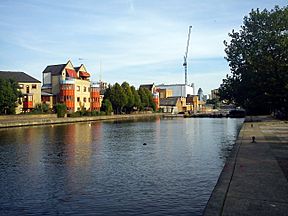City Road Basin facts for kids
Quick facts for kids City Road Basin |
|
|---|---|

City Road Basin from Graham Street Park
|
|
| Specifications | |
| Status | Open |
| Navigation authority | Canal & River Trust |
| History | |
| Date completed | 1820 |
The City Road Basin is a special water area for boats, like a small harbor, in Central London. It is part of the Regent's Canal and is looked after by the Canal & River Trust. The basin first opened in 1820. It helped the Regent's Canal become very successful.
By the 1950s, the area around the basin was mostly run down. But in 2004, work began to make it new again. Many new homes were built. In 2009, people could visit the basin for the first time. Today, the Islington Boat Club uses the basin for canoeing.
Contents
History of City Road Basin
After the Grand Junction Canal reached Paddington Basin in 1801, people wanted to connect it to the River Thames. They planned to build a canal to Limehouse. On July 13, 1812, a special law called an Act of Parliament allowed the Regent's Canal to be built.
Building the Canal
The first part of the canal opened in 1816. It went from Paddington to Camden Town. Work also started on the Islington Tunnel. But the company building the canal did not have enough money. They had trouble raising the money they needed. The canal was also costing more than they first thought.
A new law in 1813 allowed more money to be raised. But the company still struggled to get enough funds.
Help from the Government
Then, a group called the Exchequer Bill Loan Commission offered help. This group was set up to lend money for projects. These projects would create jobs for people who needed work. They agreed to lend the canal company £200,000. The company had to find another £100,000 themselves. They managed to do this.
In December 1817, work on the canal started again. In 1819, another law was passed. This law allowed the City Road Basin to be built. It also stopped plans for a different canal section. The canal finally opened on August 1, 1820. To celebrate, boats arrived from Manchester. They unloaded their goods at the basin and started their journey back north on the same day.
City Road Basin's Importance
The City Road Basin was very important for the canal's success. It was easier to reach than Paddington Basin. Soon, it became a busy place for moving goods into London. Many businesses, like the carrier company Pickfords, moved from Paddington to City Road Basin.
A lot of trade quickly grew here. Most goods from the Grand Junction Canal came only as far as City Road Basin. But there was also a growing trade in coal, wood, bricks, and sand. These building materials moved from the eastern end of the canal to places west of the basin. New buildings were being built there.
In 1826, the privately owned Wenlock Basin opened next to City Road Basin. To make boats move faster through the tunnel, a special towing boat was used from 1830. This boat used a chain on the canal bottom to pull itself along. It was used until the 1930s.
Decline of the Canal
The canal was moving many goods locally. This was different from its first plan to move imports to the Midlands. Even when the London and Birmingham Railway opened in 1838, the amount of coal carried by the canal actually went up.
However, by 1929, things changed. Railways took over the trade to the Midlands. More goods were also moved by road. Because of this, the canal and the City Road Basin slowly became less busy.

